child restraint SAAB 9-3 2002 Owners Manual
[x] Cancel search | Manufacturer: SAAB, Model Year: 2002, Model line: 9-3, Model: SAAB 9-3 2002Pages: 256, PDF Size: 11.55 MB
Page 8 of 256
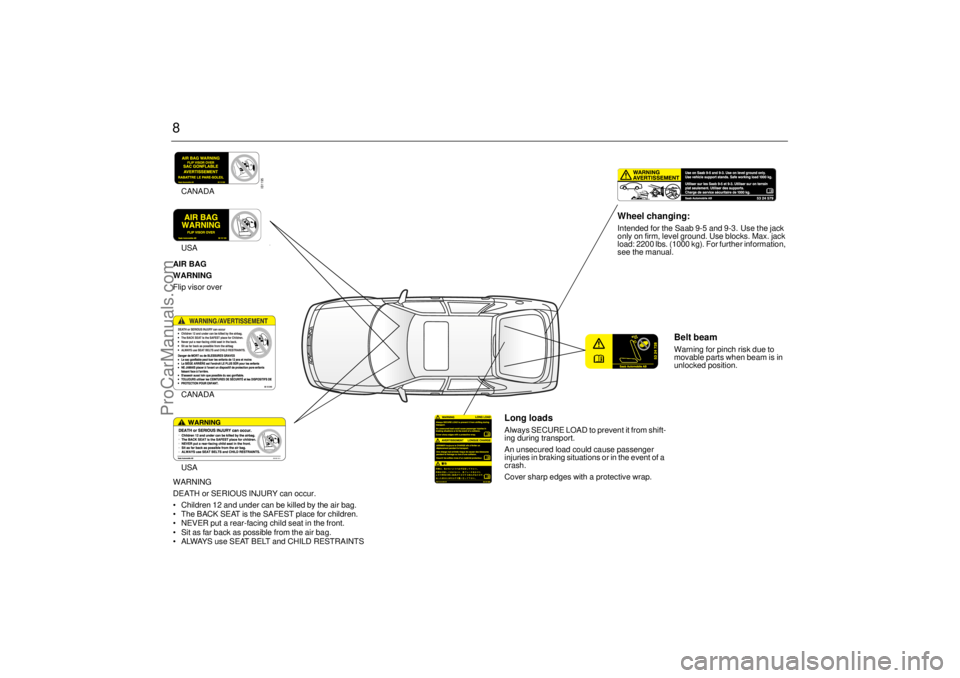
8
Long loads Always SECURE LOAD to prevent it from shift-
ing during transport.
An unsecured load could cause passenger
injuries in braking situations or in the event of a
crash.
Cover sharp edges with a protective wrap.
Belt beam Warning for pinch risk due to
movable parts when beam is in
unlocked position.
Wheel changing: Intended for the Saab 9-5 and 9-3. Use the jack
only on firm, level ground. Use blocks. Max. jack
load: 2200 lbs. (1000 kg). For further information,
see the manual.
AIR BAG
WARNING
Flip visor over
50 10 111
WARNING
DEATH or SERIOUS INJURY can occur.
Children 12 and under can be killed by the air bag.
The BACK SEAT is the SAFEST place for children.
NEVER put a rear-facing child seat in the front.
Sit as far back as possible from the air bag.
ALWAYS use SEAT BELT and CHILD RESTRAINTS
IB1195
USA CANADA
USACANADA
ProCarManuals.com
Page 11 of 256
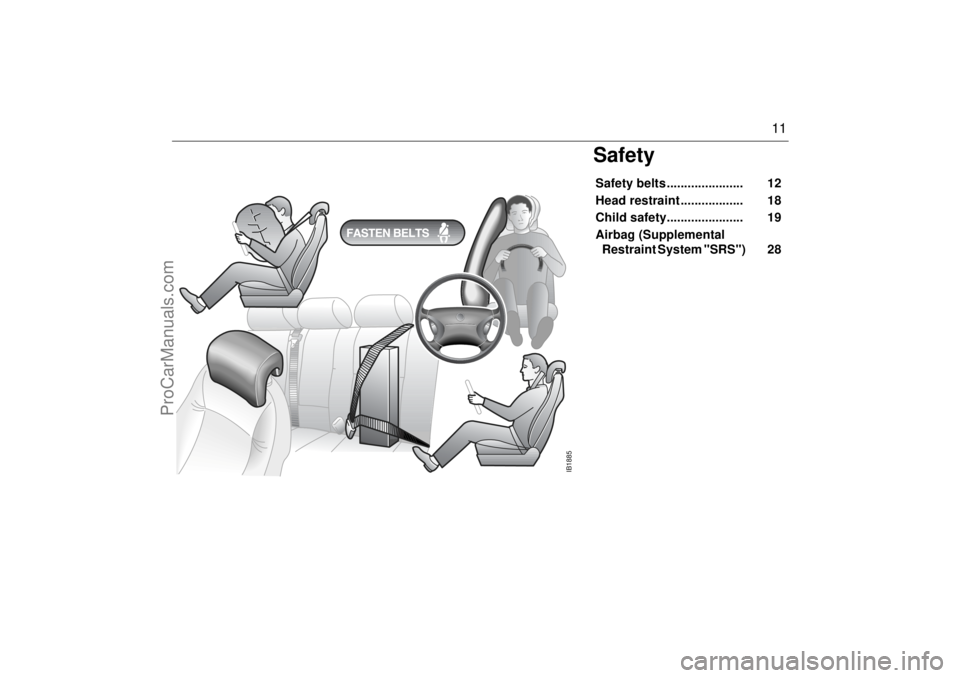
11
SafetySafety belts ...................... 12
Head restraint .................. 18
Child safety...................... 19
Airbag (Supplemental
Restraint System "SRS") 28
IB1885
ProCarManuals.com
Page 15 of 256
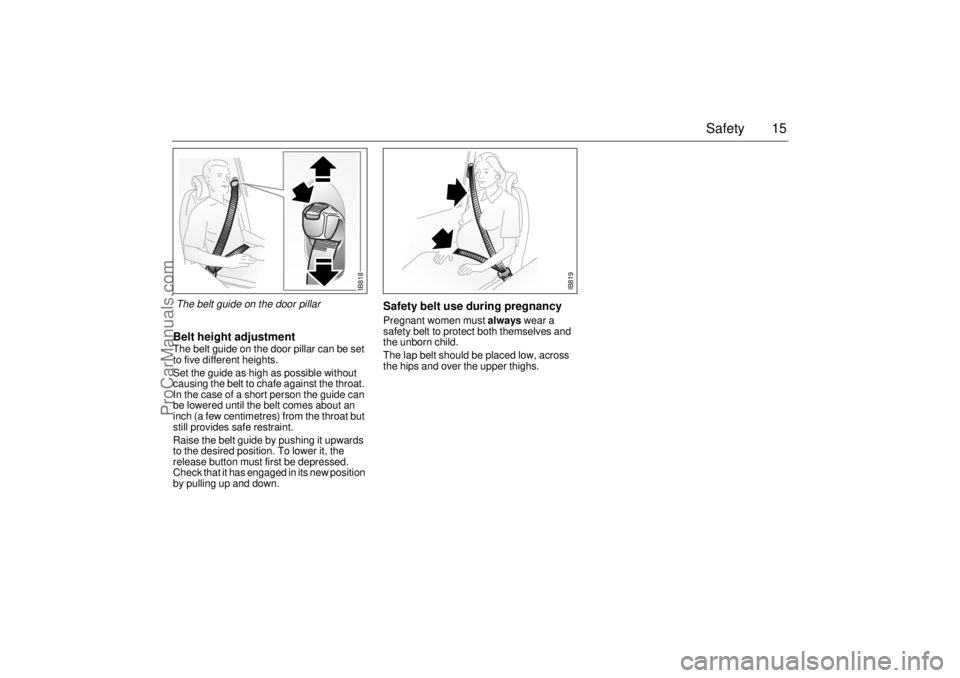
15 Safety
Belt height adjustmentThe belt guide on the door pillar can be set
to five different heights.
Set the guide as high as possible without
causing the belt to chafe against the throat.
In the case of a short person the guide can
be lowered until the belt comes about an
inch (a few centimetres) from the throat but
still provides safe restraint.
Raise the belt guide by pushing it upwards
to the desired position. To lower it, the
release button must first be depressed.
Check that it has engaged in its new position
by pulling up and down.
Safety belt use during pregnancyPregnant women must always wear a
safety belt to protect both themselves and
the unborn child.
The lap belt should be placed low, across
the hips and over the upper thighs.
IB818
The belt guide on the door pillar
IB819
ProCarManuals.com
Page 19 of 256
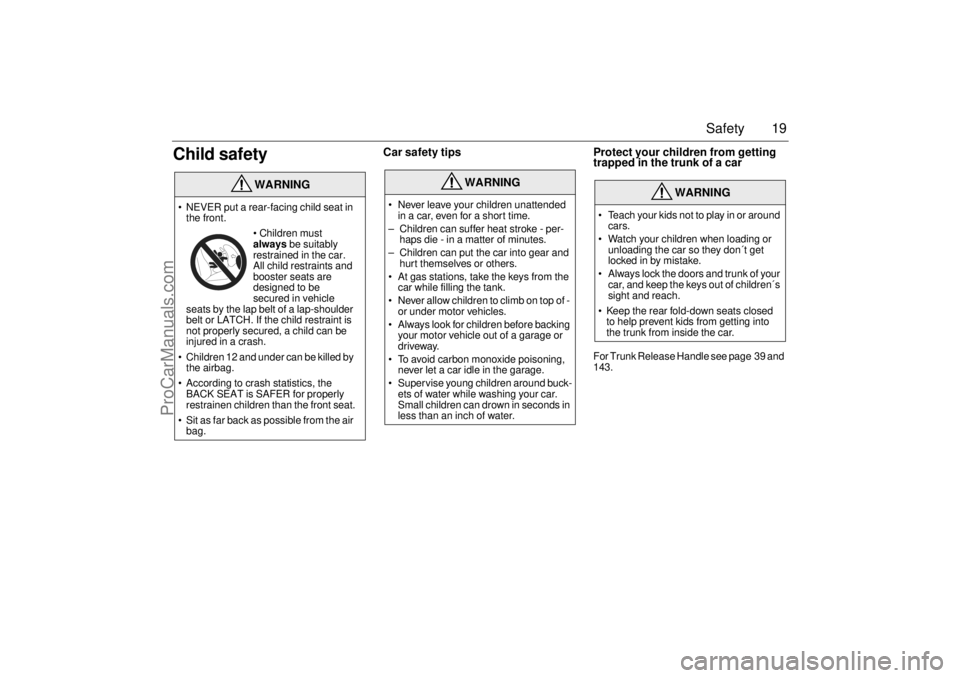
19 Safety
Child safety
Car safety tips Protect your children from getting
trapped in the trunk of a car
For Trunk Release Handle see page 39 and
143.
WARNING
NEVER put a rear-facing child seat in
the front.
Children must
always be suitably
restrained in the car.
All child restraints and
booster seats are
designed to be
secured in vehicle
seats by the lap belt of a lap-shoulder
belt or LATCH. If the child restraint is
not properly secured, a child can be
injured in a crash.
Children 12 and under can be killed by
the airbag.
According to crash statistics, the
BACK SEAT is SAFER for properly
restrainen children than the front seat.
Sit as far back as possible from the air
bag.
WARNING
Never leave your children unattended
in a car, even for a short time.
– Children can suffer heat stroke - per-
haps die - in a matter of minutes.
– Children can put the car into gear and
hurt themselves or others.
At gas stations, take the keys from the
car while filling the tank.
Never allow children to climb on top of -
or under motor vehicles.
Always look for children before backing
your motor vehicle out of a garage or
driveway.
To avoid carbon monoxide poisoning,
never let a car idle in the garage.
Supervise young children around buck-
ets of water while washing your car.
Small children can drown in seconds in
less than an inch of water.
WARNING
Teach your kids not to play in or around
cars.
Watch your children when loading or
unloading the car so they don´t get
locked in by mistake.
Always lock the doors and trunk of your
car, and keep the keys out of children´s
sight and reach.
Keep the rear fold-down seats closed
to help prevent kids from getting into
the trunk from inside the car.
ProCarManuals.com
Page 20 of 256
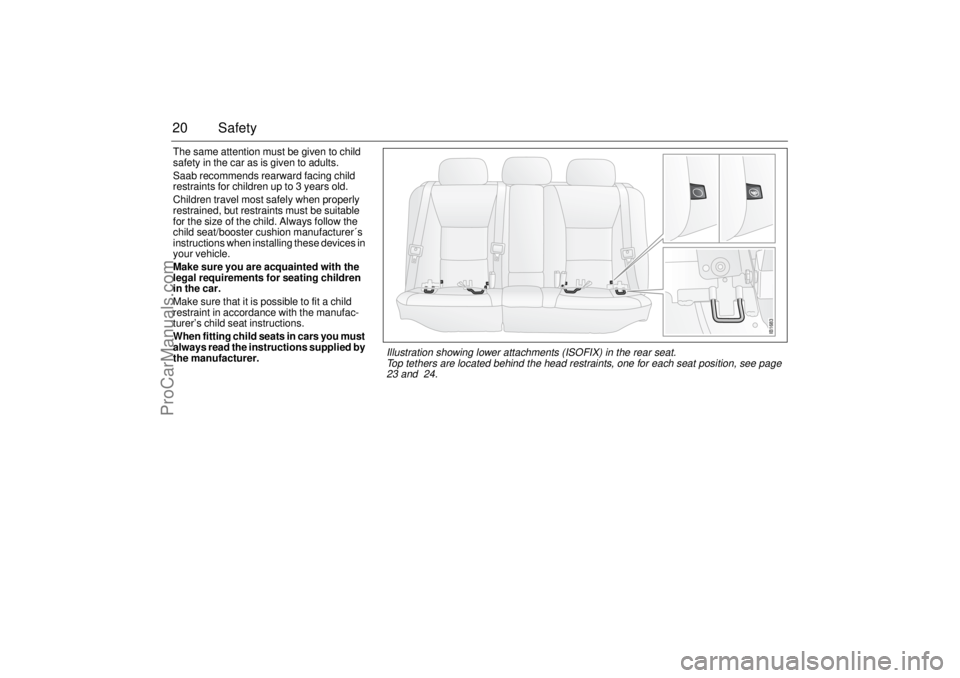
20 SafetyThe same attention must be given to child
safety in the car as is given to adults.
Saab recommends rearward facing child
restraints for children up to 3 years old.
Children travel most safely when properly
restrained, but restraints must be suitable
for the size of the child. Always follow the
child seat/booster cushion manufacturer´s
instructions when installing these devices in
your vehicle.
Make sure you are acquainted with the
legal requirements for seating children
in the car.
Make sure that it is possible to fit a child
restraint in accordance with the manufac-
turer’s child seat instructions.
When fitting child seats in cars you must
always read the instructions supplied by
the manufacturer.
IB1683
Illustration showing lower attachments (ISOFIX) in the rear seat.
Top tethers are located behind the head restraints, one for each seat position, see page
23 and 24.
ProCarManuals.com
Page 21 of 256
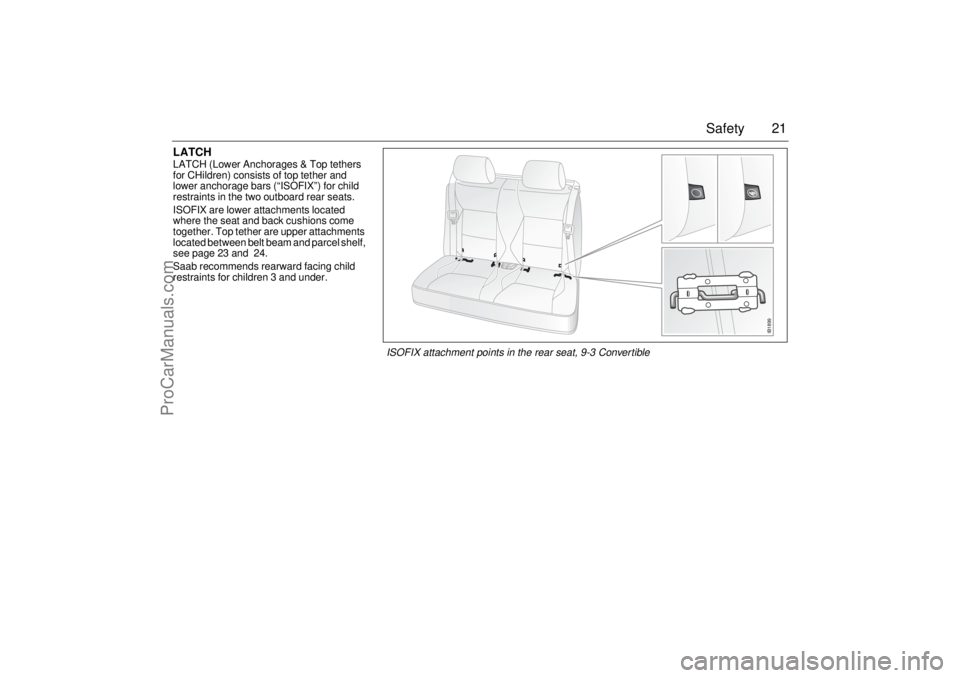
21 Safety
LATCHLATCH (Lower Anchorages & Top tethers
for CHildren) consists of top tether and
lower anchorage bars (“ISOFIX”) for child
restraints in the two outboard rear seats.
ISOFIX are lower attachments located
where the seat and back cushions come
together. Top tether are upper attachments
located between belt beam and parcel shelf,
see page 23 and 24.
Saab recommends rearward facing child
restraints for children 3 and under.
IB1899
ISOFIX attachment points in the rear seat, 9-3 Convertible
ProCarManuals.com
Page 22 of 256
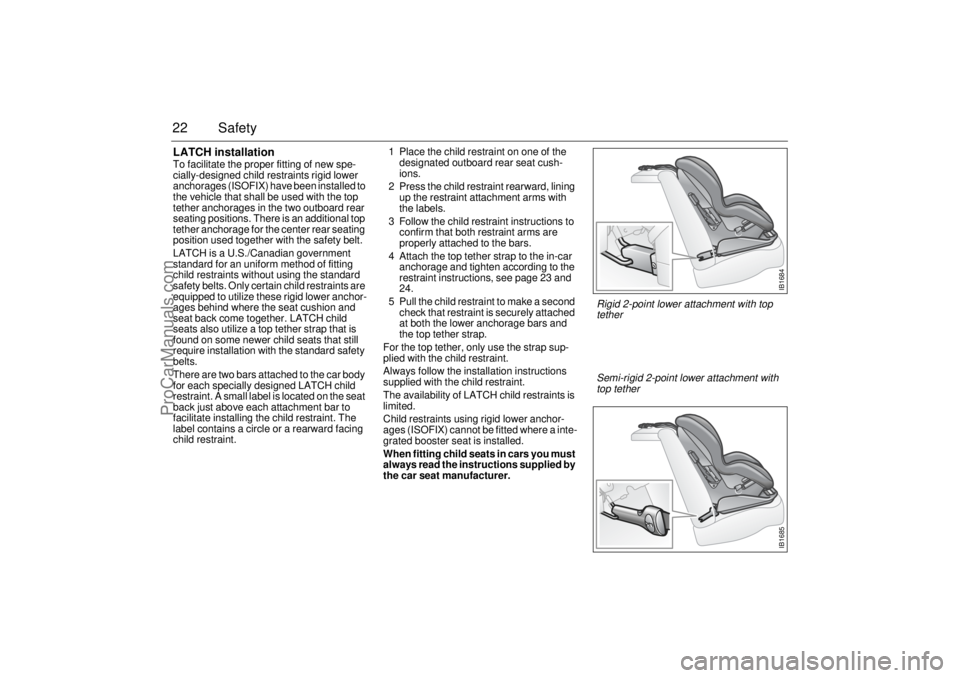
22 SafetyLATCH installationTo facilitate the proper fitting of new spe-
cially-designed child restraints rigid lower
anchorages (ISOFIX) have been installed to
the vehicle that shall be used with the top
tether anchorages in the two outboard rear
seating positions. There is an additional top
tether anchorage for the center rear seating
position used together with the safety belt.
LATCH is a U.S./Canadian government
standard for an uniform method of fitting
child restraints without using the standard
safety belts. Only certain child restraints are
equipped to utilize these rigid lower anchor-
ages behind where the seat cushion and
seat back come together. LATCH child
seats also utilize a top tether strap that is
found on some newer child seats that still
require installation with the standard safety
belts.
There are two bars attached to the car body
for each specially designed LATCH child
restraint. A small label is located on the seat
back just above each attachment bar to
facilitate installing the child restraint. The
label contains a circle or a rearward facing
child restraint. 1 Place the child restraint on one of the
designated outboard rear seat cush-
ions.
2 Press the child restraint rearward, lining
up the restraint attachment arms with
the labels.
3 Follow the child restraint instructions to
confirm that both restraint arms are
properly attached to the bars.
4 Attach the top tether strap to the in-car
anchorage and tighten according to the
restraint instructions, see page 23 and
24.
5 Pull the child restraint to make a second
check that restraint is securely attached
at both the lower anchorage bars and
the top tether strap.
For the top tether, only use the strap sup-
plied with the child restraint.
Always follow the installation instructions
supplied with the child restraint.
The availability of LATCH child restraints is
limited.
Child restraints using rigid lower anchor-
ages (ISOFIX) cannot be fitted where a inte-
grated booster seat is installed.
When fitting child seats in cars you must
always read the instructions supplied by
the car seat manufacturer.
IB1684IB1685
Rigid 2-point lower attachment with top
tether
Semi-rigid 2-point lower attachment with
top tether
ProCarManuals.com
Page 23 of 256
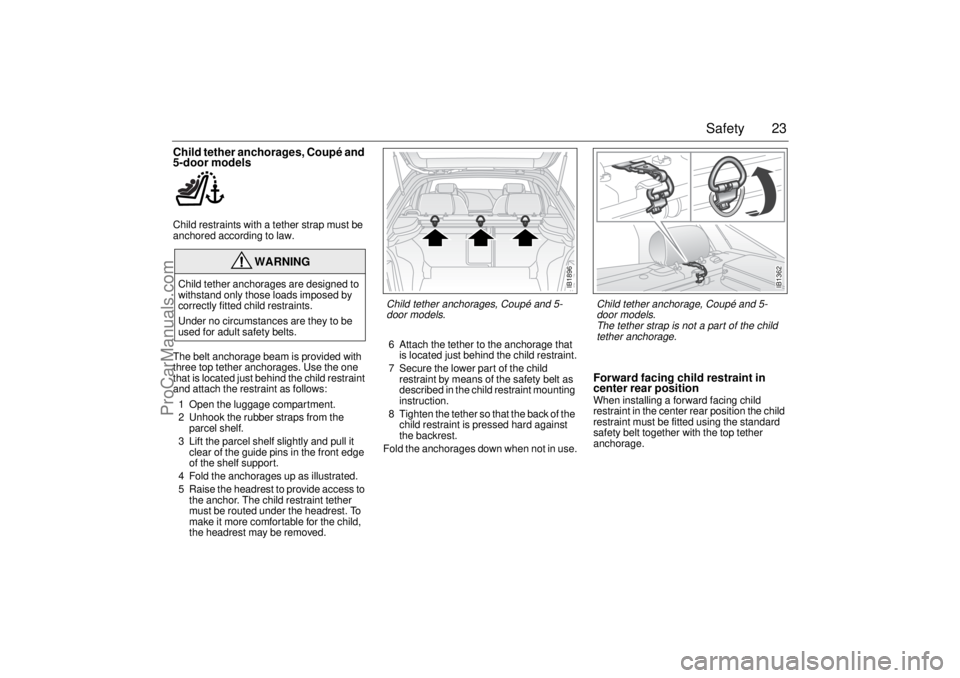
23 Safety
Child tether anchorages, Coupé and
5-door modelsChild restraints with a tether strap must be
anchored according to law.
The belt anchorage beam is provided with
three top tether anchorages. Use the one
that is located just behind the child restraint
and attach the restraint as follows:
1 Open the luggage compartment.
2 Unhook the rubber straps from the
parcel shelf.
3 Lift the parcel shelf slightly and pull it
clear of the guide pins in the front edge
of the shelf support.
4 Fold the anchorages up as illustrated.
5 Raise the headrest to provide access to
the anchor. The child restraint tether
must be routed under the headrest. To
make it more comfortable for the child,
the headrest may be removed.6 Attach the tether to the anchorage that
is located just behind the child restraint.
7 Secure the lower part of the child
restraint by means of the safety belt as
described in the child restraint mounting
instruction.
8 Tighten the tether so that the back of the
child restraint is pressed hard against
the backrest.
Fold the anchorages down when not in use.
Forward facing child restraint in
center rear positionWhen installing a forward facing child
restraint in the center rear position the child
restraint must be fitted using the standard
safety belt together with the top tether
anchorage.
WARNING
Child tether anchorages are designed to
withstand only those loads imposed by
correctly fitted child restraints.
Under no circumstances are they to be
used for adult safety belts.
IB1362
Child tether anchorage, Coupé and 5-
door models.
The tether strap is not a part of the child
tether anchorage.
IB1896
Child tether anchorages, Coupé and 5-
door models.
ProCarManuals.com
Page 24 of 256
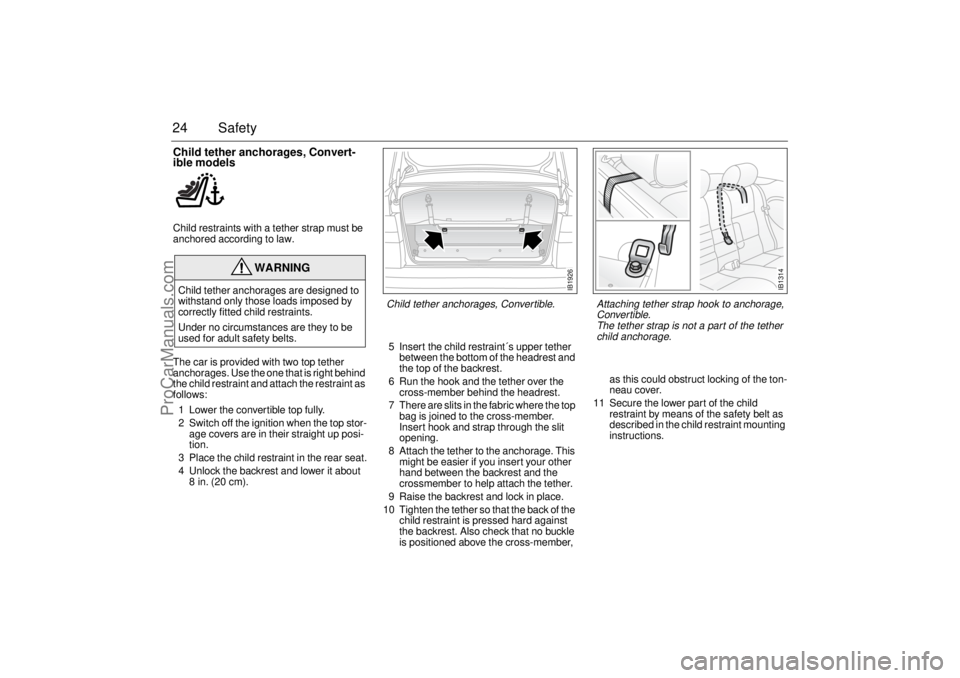
24 SafetyChild tether anchorages, Convert-
ible modelsChild restraints with a tether strap must be
anchored according to law.
The car is provided with two top tether
anchorages. Use the one that is right behind
the child restraint and attach the restraint as
follows:
1 Lower the conver tible top fully.
2 Switch off the ignition when the top stor-
age covers are in their straight up posi-
tion.
3 Place the child restraint in the rear seat.
4 Unlock the backrest and lower it about
8in. (20cm).5 Insert the child restraint´s upper tether
between the bottom of the headrest and
the top of the backrest.
6 Run the hook and the tether over the
cross-member behind the headrest.
7 There are slits in the fabric where the top
bag is joined to the cross-member.
Insert hook and strap through the slit
opening.
8 Attach the tether to the anchorage. This
might be easier if you insert your other
hand between the backrest and the
crossmember to help attach the tether.
9 Raise the backrest and lock in place.
10 Tighten the tether so that the back of the
child restraint is pressed hard against
the backrest. Also check that no buckle
is positioned above the cross-member, as this could obstruct locking of the ton-
neau cover.
11 Secure the lower part of the child
restraint by means of the safety belt as
described in the child restraint mounting
instructions.
WARNING
Child tether anchorages are designed to
withstand only those loads imposed by
correctly fitted child restraints.
Under no circumstances are they to be
used for adult safety belts.
IB1314
Attaching tether strap hook to anchorage,
Conver tible.
The tether strap is not a part of the tether
child anchorage.
IB1926
Child tether anchorages, Convertible.
ProCarManuals.com
Page 25 of 256
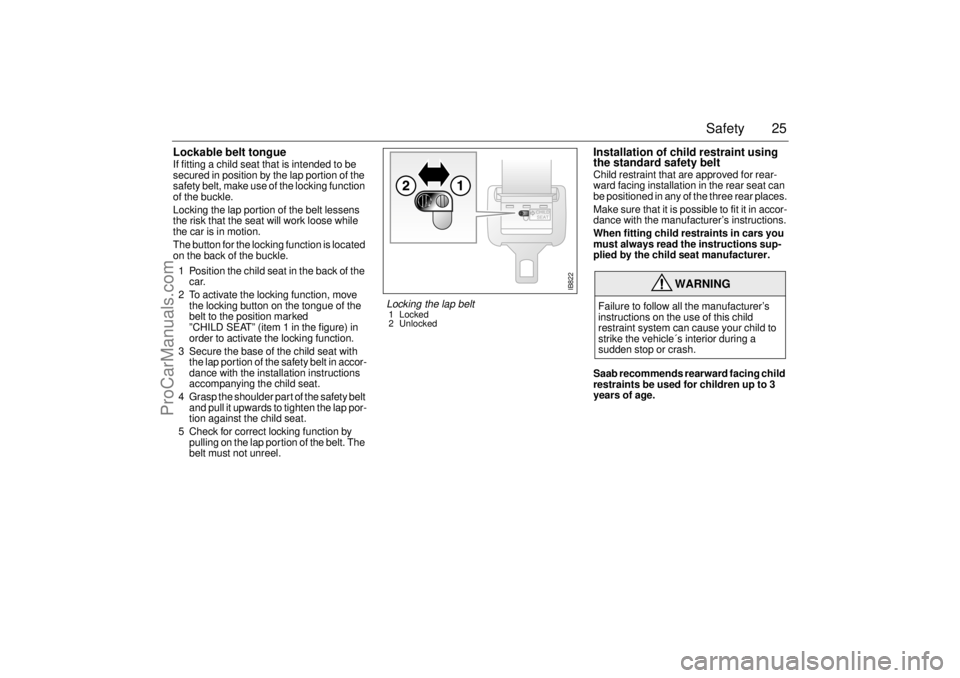
25 Safety
Lockable belt tongue If fitting a child seat that is intended to be
secured in position by the lap portion of the
safety belt, make use of the locking function
of the buckle.
Locking the lap portion of the belt lessens
the risk that the seat will work loose while
the car is in motion.
The button for the locking function is located
on the back of the buckle.
1 Position the child seat in the back of the
car.
2 To activate the locking function, move
the locking button on the tongue of the
belt to the position marked
”CHILD SEAT” (item 1 in the figure) in
order to activate the locking function.
3 Secure the base of the child seat with
the lap portion of the safety belt in accor-
dance with the installation instructions
accompanying the child seat.
4 Grasp the shoulder part of the safety belt
and pull it upwards to tighten the lap por-
tion against the child seat.
5 Check for correct locking function by
pulling on the lap portion of the belt. The
belt must not unreel.
Installation of child restraint using
the standard safety beltChild restraint that are approved for rear-
ward facing installation in the rear seat can
be positioned in any of the three rear places.
Make sure that it is possible to fit it in accor-
dance with the manufacturer’s instructions.
When fitting child restraints in cars you
must always read the instructions sup-
plied by the child seat manufacturer.
Saab recommends rearward facing child
restraints be used for children up to 3
years of age.
WARNING
Failure to follow all the manufacturer’s
instructions on the use of this child
restraint system can cause your child to
strike the vehicle´s interior during a
sudden stop or crash.
IB822
Locking the lap belt 1 Locked
2 Unlocked
ProCarManuals.com